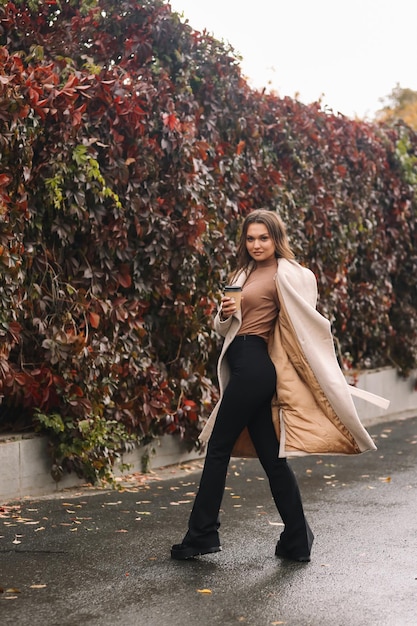Master the Art of Layering: A Style Guide for All Seasons

The art of layering involves strategically combining clothing items to create stylish and functional outfits suitable for any season, enhancing both comfort and aesthetic appeal through thoughtful coordination.
Discover the secrets to transforming your wardrobe with the art of layering. This comprehensive guide, the art of layering, will teach you how to create stylish and functional outfits that adapt to any season, ensuring you always look and feel your best.
Understanding the Basics of Layering
Layering is more than just throwing on extra clothes; it’s a strategic approach to building outfits that are both visually appealing and adaptable to changing weather conditions. By understanding the fundamental principles, you can create versatile looks that keep you comfortable and stylish throughout the year.
The Importance of Fabric Choice
Selecting the right fabrics is crucial for effective layering. Different materials offer varying levels of insulation and breathability, influencing how well your layers work together to regulate body temperature.
- Base Layers: Opt for moisture-wicking fabrics like merino wool or synthetic blends to keep sweat away from your skin.
- Mid Layers: Choose insulating materials such as fleece or down to trap warmth.
- Outer Layers: Select water-resistant or waterproof fabrics like Gore-Tex to protect against the elements.
Fabric choice ensures each layer performs optimally, contributing to your overall comfort and style.
Fit and Silhouette
The fit of each layer is essential for both comfort and appearance. Start with a fitted base layer and gradually increase the volume as you move outwards.

Consider the overall silhouette you want to achieve. A bulky sweater over a fitted shirt can create a relaxed, casual look, while a tailored blazer over a thin turtleneck offers a more polished and professional appearance.
Understanding the basics of fabric and fit ensures you create layers that are both comfortable and stylish, enhancing your overall look.
Building Your Base Layer
The base layer is the foundation of any layered outfit, worn closest to the skin. Its primary function is to manage moisture and provide a comfortable foundation for subsequent layers.
Choosing the Right Material
The ideal base layer material depends on the weather conditions and your activity level. Consider moisture-wicking fabrics that keep you dry and comfortable.
- Merino Wool: Excellent for cold weather, offering warmth, breathability, and odor resistance.
- Synthetic Blends: Ideal for high-intensity activities, wicking moisture and drying quickly.
- Cotton: Suitable for mild temperatures, but avoid in high-sweat situations as it retains moisture.
Selecting the right material ensures your base layer effectively manages moisture, keeping you comfortable throughout the day.
Essential Base Layer Items
A well-chosen base layer can make a significant difference in your overall comfort and style. Here are some essential items to consider:
A well-chosen base layer can make a significant difference in your overall comfort and style. Here are some essential items to consider:
A well-chosen base layer can make a significant difference in your overall comfort and style. Here are some essential items to consider:
- T-shirts: Versatile for everyday wear, choose moisture-wicking fabrics for added comfort.
- Long-Sleeve Shirts: Ideal for cooler temperatures, providing additional warmth and coverage.
- Thermal Underwear: Essential for cold weather, trapping heat and wicking moisture.
Building your base layer with the right materials and items ensures a comfortable and functional foundation for your layered outfits.
Mastering the Mid Layer
The mid layer serves as the primary insulation layer, trapping heat and providing warmth. It’s essential to choose materials and styles that offer both comfort and versatility.
Insulating Materials
Selecting the right insulating material is crucial for maintaining warmth in colder temperatures. Here are some popular options:
- Fleece: Lightweight, warm, and quick-drying, making it ideal for outdoor activities.
- Down: Excellent insulation with a high warmth-to-weight ratio, perfect for very cold conditions.
- Wool: Naturally warm and breathable, providing insulation even when wet.
Choosing the appropriate insulating material ensures your mid layer effectively traps heat, keeping you warm and comfortable.
Versatile Mid Layer Pieces
Versatile mid-layer pieces can be easily incorporated into a variety of outfits, offering both warmth and style. Consider these essential items:
- Sweaters: Available in various styles and materials, providing warmth and adding texture to your outfit.
- Cardigans: Easy to layer over shirts and dresses, offering adjustable warmth and a touch of elegance.
- Vests: Add core warmth without restricting arm movement, perfect for transitional weather.
These versatile pieces add both warmth and style, enhancing the functionality of your layered outfits.
Mastering the mid-layer involves selecting appropriate insulating materials and versatile pieces that seamlessly integrate into your wardrobe, offering both warmth and style.
Selecting the Perfect Outer Layer
The outer layer is your primary defense against the elements, providing protection from wind, rain, and snow. Choosing the right outer layer is crucial for staying comfortable and stylish in any weather.
Weather-Resistant Materials
The effectiveness of your outer layer hinges on its ability to withstand the elements. Consider these weather-resistant materials:
- Waterproof Fabrics: Gore-Tex and similar materials offer complete protection from rain and snow.
- Water-Resistant Fabrics: Provide a degree of protection from light rain, but may not be suitable for heavy downpours.
- Windproof Fabrics: Block wind, preventing chills and maintaining warmth.

Choosing the correct material ensures your outer layer effectively shields you from the elements, keeping you dry and comfortable.
Stylish and Functional Outerwear
Outerwear should not only be functional but also complement your overall style. Here are some stylish and practical options:
- Trench Coats: A classic choice, offering protection from wind and rain while adding a touch of elegance.
- Parkas: Insulated and often hooded, providing warmth and protection in cold and snowy conditions.
- Leather Jackets: A stylish and versatile option, offering wind resistance and a touch of edginess.
These stylish and functional pieces enhance your layered outfits, ensuring you stay comfortable and fashionable, regardless of the weather.
With a carefully selected outer layer, you can confidently brave the elements while maintaining a stylish and put-together appearance.
Layering for Different Seasons
The art of layering extends beyond just warmth; it’s about creating comfortable and stylish outfits that adapt to the specific challenges of each season.
Spring Layering
Spring weather can be unpredictable, requiring outfits that can adapt to both warm and cool conditions. Focus on lightweight and versatile pieces:
Spring weather can be unpredictable, requiring outfits that can adapt to both warm and cool conditions. Focus on lightweight and versatile pieces:
- Base Layer: Breathable cotton or moisture-wicking t-shirt.
- Mid Layer: Lightweight sweater or denim jacket.
- Outer Layer: Trench coat or light raincoat.
These lightweight layers allow you to adapt to fluctuating temperatures, ensuring comfort and style throughout the spring season.
Summer Layering
Summer layering is all about sun protection and creating stylish looks for cooler evenings. Opt for breathable fabrics and light layers:
Summer layering is all about sun protection and creating stylish looks for cooler evenings. Opt for breathable fabrics and light layers:
- Base Layer: Sleeveless top or lightweight blouse.
- Mid Layer: Linen shirt or lightweight cardigan.
- Outer Layer: Light denim jacket or a shawl for cooler evenings.
These light and breathable layers protect you from the sun and provide warmth on cooler nights, complementing your summer style.
Autumn Layering
Autumn is the perfect season for embracing the art of layering. Utilize materials that provide warmth and texture:
Autumn is the perfect season for embracing the art of layering. Utilize materials that provide warmth and texture:
- Base Layer: Long-sleeve t-shirt or turtleneck.
- Mid Layer: Flannel shirt, sweater, or vest.
- Outer Layer: Wool coat, bomber jacket, or trench coat.
These layers provide both warmth and style, allowing you to showcase the rich colors and textures of the autumn season.
Winter Layering
Winter layering is essential for staying warm and protected from the cold. Focus on insulated materials and weather-resistant outerwear:
Winter layering is essential for staying warm and protected from the cold. Focus on insulated materials and weather-resistant outerwear:
- Base Layer: Thermal underwear or merino wool base layer.
- Mid Layer: Fleece jacket, down vest, or wool sweater.
- Outer Layer: Parka, insulated coat, or waterproof jacket.
These layers provide maximum warmth and protection from the elements, ensuring you stay comfortable and stylish throughout the winter season.
Mastering layering for each season involves understanding the climate and choosing appropriate materials and styles to create outfits that are both functional and fashionable.
Accessorizing Your Layered Looks
Accessories play a crucial role in enhancing your layered outfits. They add personality, visual interest, and can also provide additional warmth and protection.
Scarves and Wraps
Scarves and wraps are versatile accessories that can transform your layered looks. Consider these options:
- Wool Scarves: Provide warmth and texture, perfect for cold weather.
- Silk Scarves: Add elegance and sophistication, ideal for spring and autumn.
- Infinity Scarves: Easy to style and offer warmth without bulk.
These accessories enhance your style while providing additional warmth and protection, complementing your layered outfits.
Hats and Gloves
Hats and gloves are essential for staying warm and protected in colder months. Choose accessories that complement your outfit and personal style:
- Beanies: Casual and warm, perfect for everyday wear.
- Gloves: Leather or wool gloves provide warmth and add a touch of sophistication.
- Hats: Wide-brimmed hats offer sun protection in the summer and add style to any outfit.
These accessories are both functional and fashionable, ensuring you stay comfortable and stylish in any weather.
By carefully selecting and incorporating accessories, you can elevate your layered outfits, adding personal touches and ensuring you stay comfortable and stylish year-round.
| Key Aspect | Brief Description |
|---|---|
| 🧣 Fabric Choice | Select moisture-wicking base layers, insulating mid-layers, and weather-resistant outer layers. |
| 🧥 Outer Layer | Choose trench coats, parkas, and leather jackets for both style and weather protection. |
| 🧤 Accessories | Add scarves, hats, and gloves to enhance your style and provide extra warmth. |
| 🌡️ Seasonal Adaptations | Adjust layers for spring, summer, autumn, and winter with appropriate materials. |
FAQ
Merino wool is an excellent choice for cold weather base layers. It provides warmth, breathability, and natural odor resistance, making it ideal for keeping you comfortable in chilly conditions.
Consider fleece, down, or wool for your mid-layer. Fleece is lightweight and quick-drying, down offers high warmth-to-weight ratio, and wool remains warm even when wet. Choose based on your activity level and climate.
Look for waterproof fabrics like Gore-Tex, which provide complete protection from rain and snow. Ensure the seams are sealed for maximum water resistance and choose a style that fits your needs.
Opt for lightweight and versatile pieces. A breathable base layer, a light sweater or denim jacket as a mid-layer, and a trench coat or raincoat as an outer layer will help you adapt to fluctuating temperatures.
Scarves, hats, and gloves are essential accessories for layered outfits. Wool scarves provide warmth, while hats and gloves protect you from the cold, adding both style and functionality to your look.
Conclusion
Mastering the art of layering allows you to create stylish and functional outfits for any season. By understanding the basics of fabric choice, fit, and seasonal adaptations, you can confidently build layered looks that keep you comfortable and fashionable, regardless of the weather.





